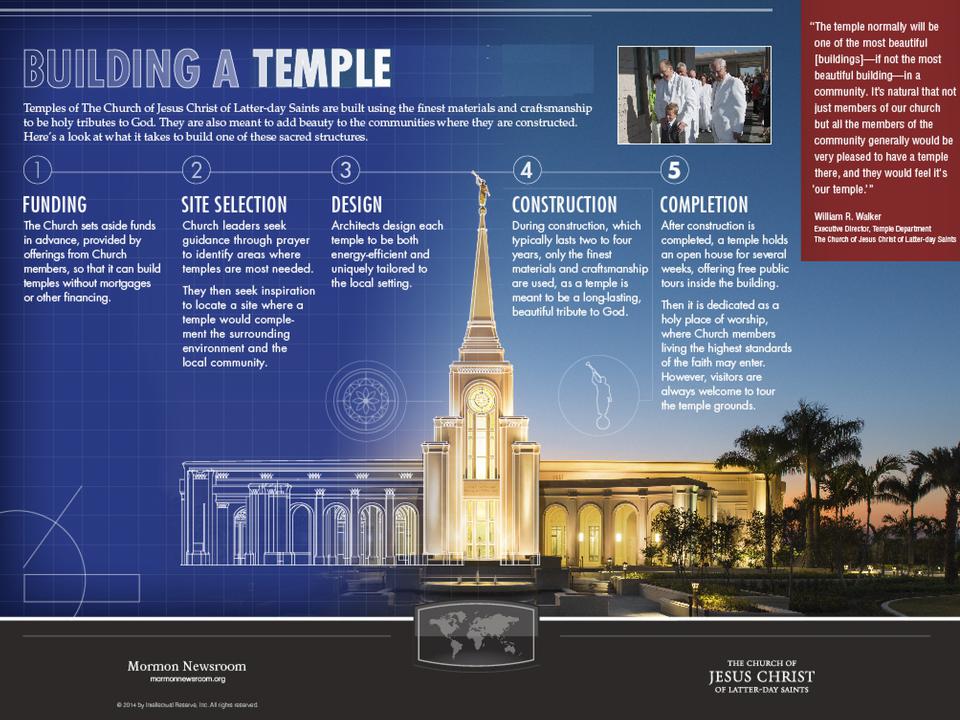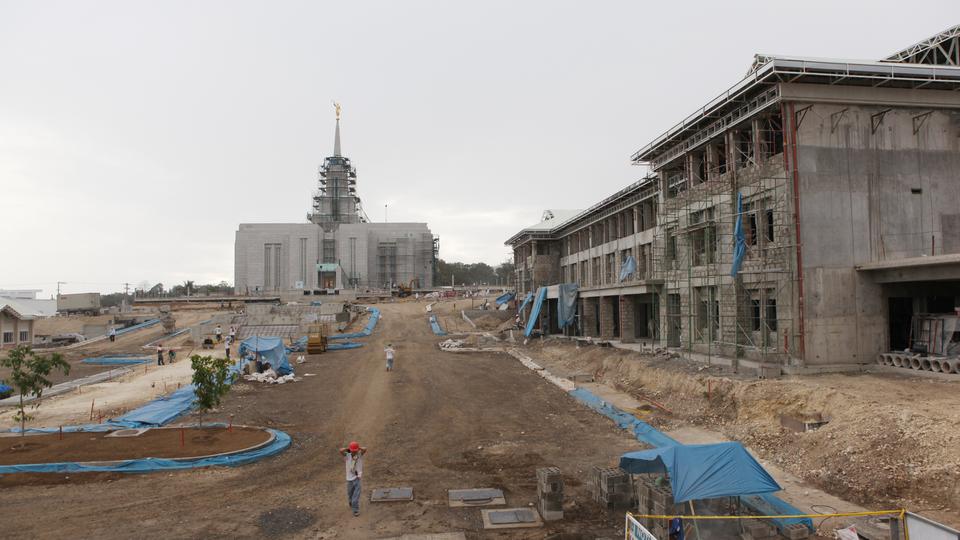| Temple Square is always beautiful in the springtime. Gardeners work to prepare the ground for General Conference. © 2012 Intellectual Reserve, Inc. All rights reserved. | 1 / 2 |
The recent groundbreaking of the Urdaneta Philippines Temple posed a question which is almost on everyone’s mind, “What’s next?”
Indeed, for those who live near temples, the Church’s completed temples are “beautiful” structures, meant to last hundreds of years thanks to their high-quality materials and rigorous building standards.
This document explains the process of building a temple from start to finish. It shows that the creation of these sacred structures is much like the construction of any other building (leaders identify a need and select a site, and architects design and contractors build), but it is also unique in many ways because of the significant role temples play in Latter-day Saint theology.
Funding, Identifying a Need and Selecting a Site
First, it’s important to note that temples are built using Church funds set aside for that purpose and that the Church pays for the costs without a mortgage or other financing. “We’ve had a long-standing practice in the Church for well over 100 years that we don’t take loans or put mortgages on properties to build temples,” says Elder William R. Walker, executive director of the Church’s Temple Department. “So we would not build a temple unless we could pay for the temple as the temple was built.”
The Church seeks to provide opportunities for members of the Church across the globe to access its temples. Eighty-five percent of members live within 200 miles (320 km) of a temple, and temple sites are generally located in areas with enough members (there’s no required number) to warrant construction, or where great distances exist between temples. Public announcements for new temples are usually made by the president of the Church at a general conference.
Once the decision is made to build a temple in a certain area, the First Presidency then prayerfully chooses the precise spot on which to build — a pattern that has been in place since the Church’s beginnings. For example, soon after entering the Salt Lake Valley in July 1847, Brigham Young identified the block of land on which to build the Salt Lake Temple. And more recently, after the Church announced in 2008 that it would build a temple in Kansas City, Missouri, President Dieter F. Uchtdorf of the First Presidency (at Church President Thomas S. Monson’s request) spent several days visiting many possible sites in the area. President Uchtdorf returned to Salt Lake City and recommended to President Monson the spot where the temple was eventually built.
Bill Williams, who has been a Church architect since 2003, says the Church looks for sites “that would have prominence, be in an attractive neighborhood, a neighborhood that would withstand the test of time.”

Design Phase and the Importance of “Sustainable Design”
After the temple site is selected and the Church determines how large the building should be (based on the number of members in the area), a team of Church architects creates potential exterior and interior designs.
While the purpose of each of the Church’s 160 temples is the same, many aspects of each structure’s inner and outer look and feel are unique, tailored to the local people and area. Williams says good architects "want to create something unique, something that has its own personality, and [Church leaders] allow us to do that” with temples. He adds that much can be done to make a temple unique, including “the decorative motifs, the kind of furniture, the interior accouterments, how articulate it is. It could be anything from the modern look that you see in the Washington D.C. Temple to something like the gothic, neoclassical look that you find in the Salt Lake Temple.”
To create a look and feel that is just right for a specific temple, architects solicit a number of sources including meeting with locals to “understand the nature of the people, the country that they live in, the members that are there and how we can better fit the temple” to them.
A critical aspect of the planning process is “sustainable design,” a concept that Williams says seeks to reduce a temple’s long-term operational cost. “Whatever we can do to make the environmental systems, the mechanical system's energy efficient, to make the interior materials have longevity so that they don't wear out straightaway, anything we can do to conserve water, it's great for us as the owner because it makes that long-term cost less. That's what it means to be sustainable.”
And with a temple’s complex systems, sustainability is no easy feat. “We’ve got thousands of systems and components that all have to work in harmony,” says Jared Doxey, the director of architecture, engineering and construction in the Church’s Physical Facilities Department. “And getting everything the way it was designed at the highest quality, it's a very complex maze of issues that have to just be 100 percent right.”
In selecting building materials, the Church settles for nothing but the best. The pattern for this, Elder Walker says, is found in the description of Solomon’s Temple in 1 Kings 7 in the Bible. “They used the finest materials and the finest workmen to build the temple. And that’s the pattern we follow,” Elder Walker says. “Not to be ostentatious, but to be beautiful in a wonderful tribute to God.”
And the role of inspiration is most important to temple design, Williams says. “These are His houses, and we would like to make sure that everybody feels that responsibility so that when we begin design meetings, we start with a word of prayer.”
The design process can take up to two years, and Elder Walker notes that all along the way — “from architectural detail clear down to colors and carpet swatches” — the First Presidency is involved and provides final approvals.

Construction Phase
Because of the high standards for building its temples, the Church sends representatives across the world to search out the best contractors. The Church uses more than a dozen contractors, and Doxey says “the complexity of the temple design requires the very best that most workers have ever had to give on a project.”
For example, Cory Karl of the Church’s Construction Services Division says that with brick masons, the Church asks “that they lay their brick in a rigorous way such that it's very uniform and consistent throughout” and thus “installed to the very best of the craftsman's abilities.”
The high building standards are in place for two main reasons: first, Latter-day Saints believe their temples are among the holiest places on earth and tributes to God; second, the Church builds these temples to last hundreds of years.
Church representatives ensure the construction companies are financially stable and able to meet Church regulations (including prohibitions against smoking, drinking and loud music on the construction site, though construction workers do not have to be Latter-day Saints). The Church then invites those selected companies to the bidding process. Once a company is chosen, construction typically takes 24 to 48 months, depending on the location.
For temple sites outside the United States, construction can take more time for a variety of reasons. “In some countries, there might be more manual labor to do things that in the United States we might have the equipment to do,” Doxey says. And Karl adds that “other circumstances besides just the temple site” can slow down the process in some international areas, including additional fees incurred by local governments.
Although it can be a challenge to find qualified contractors, the high bar is worth it for both the Church and the workers. Not only do temple construction projects supply jobs in local communities, they also provide what many construction workers consider to be the zenith of their careers. For example, Doxey says the foreman of the concrete crew on the Church’s under-construction Philadelphia Pennsylvania Temple told him that in 30 years, he’s “never seen such a well-designed project” — one that he says is so durable that it “will be here when mankind is gone.”
As was mentioned at the beginning of this piece, only Latter-day Saints who live the highest standards of the faith are permitted to enter a dedicated temple. Therefore, once construction is complete, and prior to the temple’s dedication, the Church opens the temple doors to the public for several weeks for free tours. These open houses are a rare opportunity for anyone in the community — member or otherwise — to walk through a temple and learn more about Latter-day Saint beliefs.
Then, a week or two after the open house concludes, a Church leader (usually a member of the First Presidency) formally dedicates the temple. One aspect of the dedication events is the cornerstone ceremony, where Church leaders and others place mortar around the cornerstone to symbolize the temple’s completion. Later on, Elder Walker says, the president or the person he assigns says the dedicatory prayer “to consecrate the temple that it would be used for those sacred purposes for which the temple is built.”
A Beautiful Addition to the Community
At the Twin Falls Idaho Temple open house in 2008, Elder Walker remembers how community leaders and journalists referred to that structure as “our temple,” proving to him that a temple’s beautifully built structure and immaculately kept grounds are a source of pride for local citizens. In fact, experience worldwide demonstrates that temples positively impact neighborhood property values, even in a bad economy.
“I think it just shows that the temple, normally, will be one of the most beautiful —if not the most beautiful — building in a community. It’s natural that not just members of our Church, but all the members of the community generally would be very pleased to have a temple there, and they would feel it’s ‘our temple.’ We hope that that would be the case.”